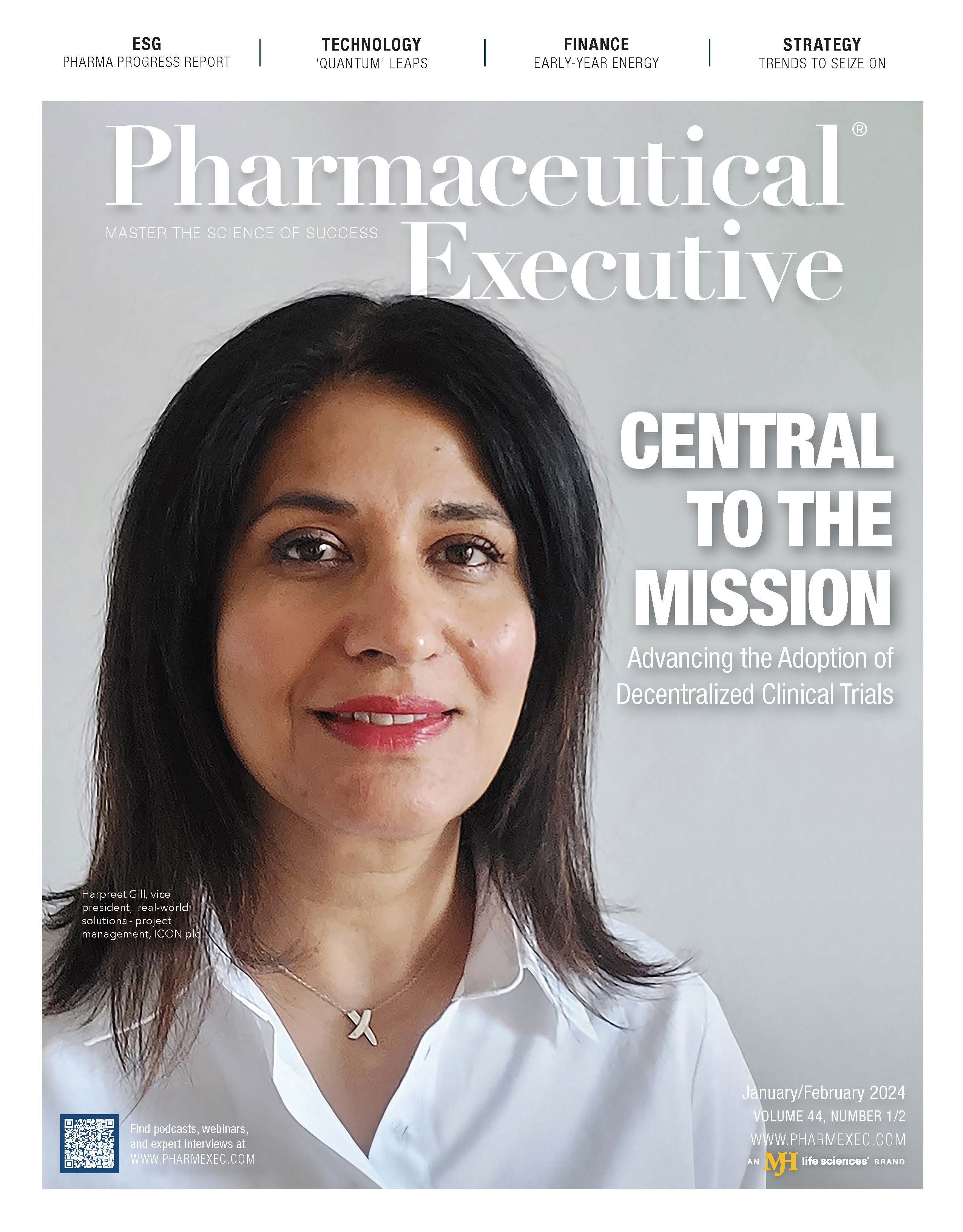Building Resiliency: Essential Leadership Principles for 2024
Embracing business imperatives such as operational efficiency and a focus on a patient-centric approach can help pharma leaders provide a stable foundation amid lingering uncertainty.
Mindy Herman
Managing principal
Life Sciences Consulting
Crowe LLP

Pharmaceutical companies face an increasingly challenging and complex environment. Macroeconomic trends, market demands for a more patient-centric approach, the regulatory environment, and the growing “patent cliff” are all pressuring executives to mitigate risk, protect the bottom line, and adapt to stakeholder expectations.
While drug manufacturers have little control over these external challenges, they can build adaptability into their operating models and patient-centric initiatives. By adopting a collaborative leadership style with clear expectations and measuring what matters most to enhance value-based decisions and strategy alignment, pharma companies can build resiliency and better adapt to the changing market.
Growing complexity and ambiguity from external challenges
Pharma organizations operate in an increasingly complex environment with many forces that are out of their control. Global macroeconomic trends, including rising inflation and interest rates, put greater financial pressures on consumers. These pressures erode consumer confidence and create greater market uncertainty.
Bo Qiu
Managing director
Life Sciences Consulting
Crowe LLP

Meanwhile, communities and patients have increasingly higher expectations for a patient-centric approach and pricing transparency. As pharma companies strive to enhance patient education, improve healthcare provider (HCP) interactions, add traceability to their delivery models, deal with ongoing supply chain challenges, and differentiate with marketing, the cost and complexities of doing business continue to grow.
This set of factors comes at a time when pharma companies struggle with new opportunities and threats from emerging technologies, growing supply chain challenges, and rising expectations from stakeholders and regulators regarding environmental, social, and governance (ESG) initiatives. Of the 125 pharmaceutical and biotechnology industry leaders surveyed in the Crowe Executive Outlook Study,1 launched in collaboration with Forbes, many noted supply chain (39%), financial risk (38%), ESG and decarbonization (38%), and regulation and taxation (37%) as the most volatile issues facing their organizations.
Pharma companies also want to maximize their return on their research and development (R&D) investments ahead of the “patent cliff.” Over the next seven years, the industry is expected to lose up to $200 billion in revenue, according to BioPharma Dive.2 As major companies lose patent protection on valuable top-selling products, they might offset revenue losses with new indications or new drug applications.
Financial pressures for pharma companies will only mount in the coming years. The Crowe Executive Outlook Study survey found that 55% of pharma and biotech industry executives anticipate an increase in capital needs for R&D by 2025, while 52% believe there will be greater volatility in clinical trial diversity, recruitment, and pricing pressures.
Building resiliency from within
Pharma executives have little control over external forces, but they do have control over internal processes. According to the Crowe study, nearly seven out of 10 (68%) of executives in the industry said they were actively increasing investment in change management, while others also want to address volatility by accessing new talent and innovation through mergers and acquisitions. Additionally, leaders said they would like to take advantage of artificial intelligence (AI) and other technology to maximize productivity and optimize the human workforce.
As they strive to adapt, one of the most impactful areas to double down on is a patient-centric approach. Using patient and healthcare provider (HCP) education, pharma companies can promote products and remain consistent with compliance. Within a clinical trial setting, they can also identify the representatively diverse population of patients to inform the results of a drug, indication, therapy, or treatment.
Pharma manufacturers are examining their operating models to determine how they can do things more efficiently, such as standardizing processes to reduce the cost of performing those tasks. Organizations can set up shared service centers to serve multiple regions and business units for repetitive tasks, including accounting functions and centralized procurement processes.
In addition, companies are using technologies to achieve higher efficiencies and better risk management. One example is integrating the reporting capability from data warehouses across core systems to gain insights into both process efficiencies and outcome metrics. The subject matter for data analytics is broad and includes financial forecasting working across finance, tax, and commercial teams; HCP transparency; ESG metrics; supply chain traceability; and internal and external information security risk management; to name a few. Harmonizing data into meaningful business intelligence helps align business functions with overlapping processes or risk mitigations.
Consider the example of information security, privacy, and third-party risk. Reviewing the underlying controls aligned to National Institute of Standards and Technology, International Organization for Standardization, or other regulatory frameworks allows companies to understand the importance of initiatives to enhance the control environment and the potential quantified impact to cyber insurance. With the appropriate governance, pharma companies can also integrate AI to discover new efficiencies. For example, in R&D processes, organizations might be able to increase efficiencies in the research, documentation, and prioritization of effort.
Finally, many pharma companies are still trying to find the right people with the right level of competencies to meet the needs of the business. Even as technology and expectations continue to evolve, employees and businesses want to be led by principle-based leaders who provide clarity of direction and purpose. Additionally, while integrating technology can offer many benefits, keeping people at the center is critical for implementation and clarity. Drugmakers need leaders that engage people, inspire ideas, and encourage collaboration to support the company’s mission.
Using metrics to guide the mission
As pharma companies work to achieve their strategic goals, direction and governance are critical. At the same time, they have an opportunity to increase clarity in aligning people and processes to their “North Star” mission statement. Doing so can help the whole organization move together toward the same goals.
To work within the context of increasingly limited resources, companies can implement a rigorous prioritization process with transparent criteria. As leaders work with their teams to yield the greatest return on investment (ROI), they can intentionally and clearly communicate with those teams to achieve prioritization buy-in. Instead of setting ambiguous goals that are hard to measure, organizations can focus on priorities that support progress.
Companies that carefully consider metrics and what they are measuring at each level of the organization have a stronger performance culture. Metrics help define desired values-based behavior, accountability, and recognition, and they can demonstrate how to align with the mission. By connecting each organizational team to the broader purpose, individuals can better understand how they can best make an impact.
Using R&D as an example, a measurable metric can orient varying R&D stakeholders to better focus on innovation and efficiency from discovery through clinical trials, and, ultimately, commercialization and postmarketing activities. Sustaining innovation can be costly, but looking past a traditional R&D organizational chart and promoting wide-reaching transparency is vital. For example, tax and finance teams can collaborate with cross-functional development teams to generate meaningful bottom-line benefits (such as R&D tax credits and the orphan drug credit). When R&D teams—including development, operations, technology, regulatory, and quality assurance—understand and buy into the ROI of these tax benefits, they empower tax and finance teams to foster strategies that align with pharma portfolio goals.
As executives help bring pharmaceuticals to market, manage team performance, and mitigate risk, they can align efforts with key performance indicators (KPIs) and key risk indicators (KRIs). Regardless of how companies categorize risk, leaders can lean into the inherent multidisciplinary (or departmental) interdependency. One of the ways to identify KPIs and KRIs is through enterprise risk management or integrated risk management. This process requires participation from leaders of major business units and functions to come together, identify, and manage top risks that overlap.
Working toward long-term success
As they face rapid technological evolution and growing pressure from regulators, pharma companies with strong core leadership principles can build resilience. Embracing business imperatives such as operational efficiency and a focus on a patient-centric approach provides a stable foundation amid uncertainty.
By using metrics to reinforce these foundational elements, pharma manufacturers can fortify their organizations against the challenges of a dynamic environment. The continued focus on principle-based leadership can foster resilience and support patient well-being and long-term success.
References
- Pharma/Biotech Organizations are Focused on Implementing Human- Centric Changes to Address Sources of Volatility. Crowe LLP. May 1, 2023. https://www.crowe.com/news/pharma-biotech-organizations-are-implementing-human-centric-changes-to-address-sources-of-volatility
- Gardner, J. Big Pharma’s Looming Threat: A Patent Cliff of ‘Tectonic Magnitude’. BioPharma Dive. February 21, 2023. https://www. biopharmadive.com/news/pharma-patent-cliff-biologic-drugs-humira-keytruda/642660/

Addressing Disparities in Psoriasis Trials: Takeda's Strategies for Inclusivity in Clinical Research
April 14th 2025LaShell Robinson, Head of Global Feasibility and Trial Equity at Takeda, speaks about the company's strategies to engage patients in underrepresented populations in its phase III psoriasis trials.
Beyond the Prescription: Pharma's Role in Digital Health Conversations
April 1st 2025Join us for an insightful conversation with Jennifer Harakal, Head of Regulatory Affairs at Canopy Life Sciences, as we unpack the evolving intersection of social media and healthcare decisions. Discover how pharmaceutical companies can navigate regulatory challenges while meaningfully engaging with consumers in digital spaces. Jennifer shares expert strategies for responsible marketing, working with influencers, and creating educational content that bridges the gap between patients and healthcare providers. A must-listen for pharma marketers looking to build trust and compliance in today's social media landscape.
Pfizer, GSK Gain ACIP Recommendations for RSV and Meningococcal Vaccines
April 18th 2025The Centers for Disease Control and Prevention’s Advisory Committee on Immunization Practices voted to expand access to Pfizer’s respiratory syncytial virus vaccine Abrysvo for high-risk adults in their 50s and voted in favor of GSK’s meningococcal vaccine, Penmenvy, for streamlined adolescent protection.